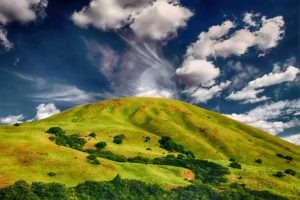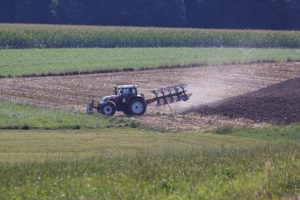(This post may contain affiliate links. I will earn a commission at no extra cost to you.)
 Plowed fields (or Ploughed if you’re on the other side of the Atlantic) are a popular site that detectorists always visit.
Plowed fields (or Ploughed if you’re on the other side of the Atlantic) are a popular site that detectorists always visit.
I’ll explain what is the difference between metal detecting fields in the UK and The US. And what’s the best way to do that in each case.
Then, I’ll give you some tips. And finally, I’ll talk about why detectorists think plowed fields are a good spot to hunt.
Table of Contents
What is the best way to metal detect a plowed field?
The US history is too short. So you can’t hunt any random field, and you can’t go swing your coil all over the place.
In the UK and Europe, in general, you can do that because the fields have been cultivated for thousands of years. You can certainly find stuff in a random field like coins from the Roman era.
Hunting US fields
In the US, you have to be strategic. Do some research before hitting the soil with the coil.
This means that you have to find locations in the plowed field where there’s (or was) human activity.
It’s true that at first glance, it looks just a normal field…
However, small villages, houses, farm, barns, schools, churches, old picnic areas…may have existed in the past in the field.
These are the spots you should find and metal detect. You’ll find the goodies there. You may find some buried items elsewhere on the farm.
But, this will be rare (unless you live in Europe). Moreover, it’s easier to hunt limited areas than the whole field.
So, how do you find this spots?
Historic clues
Old plat maps (1870 and before) and county atlas will tell you who owned the land at a given time. You’ll find also the location of cities, churches, houses…when the map was drawn.
You can find these maps in your local museum, historical societies, local libraries… Some of the plat maps are available online.
If you find what you want online, that’s good. If not, you have to go to the library, study the maps and take pictures of them with a good camera. I don’t think you can take these historical documents with you. They’re old and fragile.
Look for plat maps displaying the same location over the years to track the changes occurring there. (Example: 1870 then 1900 then 1930 and so on).
You can print the plat maps’ pictures to take them with you to the fields. Match them with google maps. Pin the location to make finding them easier.
Read old newspapers or any document talking about the history of the area, the population, their activities, the places where they used to gather…
Historic aerial photos are helpful too. You can get a good overview of the field.
Use old photos or hand drawings of the buildings that used to be there and compare them with landmarks as you’re walking the area.
The older the house the better because you can find older coins and other valuable items that belonged to the first settlers in the US.
Use the historical documents you have to find farms that are adjacent to Civil War battlefields or camps if you’re looking for civil war relics.
Visual clues
In addition to the historical clues, you can find old buildings’ locations using visual clues like the remains of old foundations, old wells, windmills, scattered pieces of glass, pottery, broken bricks, nails…
Some prefer to build their houses on hilltops to protect them from floods. High spots are a good starting point to look for clues and to have a good overview of the field.
Objects could sink and slide from the top of the mound to its base over the years. So make sure you look there too.
They didn’t have cars in the old days, they used horses. So if you find horseshoes, harness rings, tacks…You should be in the right spot.
If you find oil lamp parts, that’s a good sign because they didn’t have electricity.
Tree lines are a good sign too. If they’re arranged in a certain pattern and not scattered all over the place, or if you find them in the prairie where trees don’t grow naturally, certainly someone planted them.
For example, evergreen trees are used as windbreaks for farms. A little bit closer to the house, you could find deciduous trees to provide shade during the summer.
If you find tree patterns and there’s no building close by, this should be a good place to metal detect.
Ask
You can ask the farmer and the locals about old buildings that used to be in the area. And whether he found some broken pieces of glass or pottery.
Show him the plat maps and the historic aerial photos to help you locate the old buildings.
Metal detector
Use the best tool you have, your metal detector. The zero discrimination mode will be ideal because you want to find the good spots before hunting the goodies.
Usually, there’s no trash like in the parks or schoolyards. So the all metal mode won’t annoy you.
If you find a high concentration of metal objects, there should be an old house or an old camping site where you can find the coins you’re looking for.
Hunting European farms
 If you live in the UK or in another European country, you can find buried items all over the place. So you can metal detect anywhere in the field.
If you live in the UK or in another European country, you can find buried items all over the place. So you can metal detect anywhere in the field.
And you don’t have to work as a detective or a historian looking for clues and signs of human activity.
However, these tricks may help you a lot and save you some time. Remember the farmer will start drilling the grain soon. So consider spending some time researching the history of the plowed field you want to metal detect.
To make the trip more organized, follow the traces of the plow or the roller back and forth in straight lines.
Make sure that you covered all the area by overlapping the swings of adjacent lines.
If you didn’t cover all the field in one day (and surely you won’t), you can mark the point you’ve reached with your shovel or with a stick and come back the next day.
You can also work your way perpendicular to plow tracks to be able to swing the coil easier.
Tips for hunting plowed fields
Always ask for permission and fill the holes you dig. Livestock and humans could break an ankle when they step into a hole. Don’t destroy the crops…
Plowed fields are uneven (crests and troughs). Therefore, you need a pair of boots with high ankles to provide good support for your legs.
The second problem is that the swings’ magnitude will be limited and you’ll lose some depth in the trough. So adjust the coil’s height and make sure it’s close as possible to the ground.
If the ground is rocky, use a coil cover to protect it from cracks and scratches.
If you want to increase the depth range of your detector, use a big coil. They’re not good for trashy areas (sniper coils are).
But a farm isn’t like a park or picnic area where you’ll find a lot of pull tabs and bottle caps. Larger coils are less sensitive for small targets.
Fields are far away from stores and from main roads. So make sure you’re ready.
Bring extra batteries. You don’t want them to die in the middle of the hunt. And don’t forget water and snacks.
The good thing about plowed fields is that you can give it a visit another time and you’ll still find items that were deep last year and brought back to the surface this time.
If you plan to come back to the site again, clean the area of any junk you find because it may bother the next year. Digging the same trash twice isn’t a fun thing to do.
Wear clearly visible clothes, you don’t want to be shot by someone thinking you a deer. This could happen especially during the hunting season.
Ask the owner if he already gave a permission to a hunter to enter his land.
What makes fields good for detectorists?
Digging holes in the fields and in the woods, in general, is easier than in parks. Because you can use a shovel instead of a small hand digging tool.
If your shovel is heavy or too long you can pick a folding spade. They’re easier to carry and they can be used as a hoe too if the ground is hard to dig.
In the fields, you can dig as many holes as want. If you’re a fan of “dig everything”, that’s good for you.
You don’t have to worry about cutting a neat clean plug and make things look like nobody dig a hole there. Just fill it so that nobody triples and keep moving.
In parks, you should preserve the grass especially in places like Nevada where grass don’t usually grow naturally or during the summer. In the woods, this is not a problem.
There’s less junk in the fields than in urban yards but you may find occasionally some cans, pull tabs, gun shells, lead bullets, and Indian arrowheads.
Fields are more promising than the woods. Because they’re constantly plowed and buried metal objects will be brought back to the surface or close to it. In the woods, buried items will sink and stay there.
In many cases, there’s more human activity in the fields than in the woods unless it’s close to a city, a hiking trail or camping site… This means that you can find more goodies in the fields than in forests (not always).
You can’t metal detect always in the fields. They’re available when they’re plowed or just after the harvest. You can always metal detect pastures.
You can metal detect the same field twice: after the crops where harvested and after the field was plowed.
This way, you can double your finds from the same area. You dig what’s on the surface for the first time then the plow will flip the dirt and you could possibly find other items.
This is not always feasible. For example, it will be difficult to hunt a cornfield right after harvest because of the corn stalk stubbles.
it’s too messy and tight between the rows. So it won’t comfortable swinging your coil between them.
However, this shouldn’t be a problem. You can hunt the same field the next year after the plowing is completed.
I hope the tips I gave are helpful. If you have more tips and tricks, please share them in the comments below. Feel free to ask questions.
